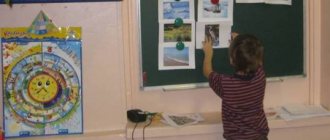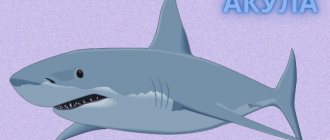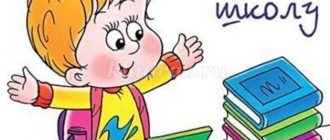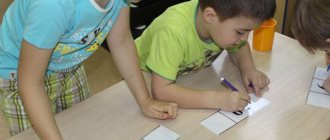Notes for children in the preparatory school group Topic: “Blue Planet”
Transcript
1 Municipal autonomous preschool educational institution of the city of Nizhnevartovsk, kindergarten 15 “Sun” Notes for children in the preparatory group for school Topic: “Blue Planet” Senior teacher: Andreeva Natalya Vasilievna Nizhnevartovsk 2014
2 Program content: Consider with children the location of planet Earth in the Universe. Look at the areas of water and land on the globe. To promote the accumulation in children of specific ideas about the properties, forms and types of water and living organisms living in water and near water. Develop speech, thinking, curiosity. Teach children to draw conclusions and conclusions. Foster curiosity and interest in experimental activities.
3 Preliminary work: Consultations for parents: “How to teach children to preserve wildlife and not pollute it”, “Educating preschoolers’ need for clean water and clean air” Creation of albums “Blue Planet” Creation of a layout “Solar Constellation” Exhibition of drawings “Earth” my home is my home." Conducting a series of experiments with water.
4 Equipment: TV for watching videos. Film on electronic media “Constellation”. Globe. Cube, ball, flasks of various shapes, saucer. Glass of milk, glass of water, illustration of water. Sugar, salt, citric acid, vegetable oil. Two microscopes with clean water and melted snow, a funnel, cotton pads, a scarf, coal. Operational cards. Didactic game "Ecological Lotto". Droplets made of colored paper (for awards)
5 Methodological techniques Watching a video about planet Earth. Looking at the globe. Looking at a world map. Experimenting to determine water clarity. Experiment on solubility in water. Working with operational maps. Use of artistic words. Didactic game, search questions. Encouraging children.
6 Children are invited to watch a video about the location of our planet Earth in the universe. Goal: To reinforce with children the difference between our planet and other planets (color, distance, size) -What did you like and remember most from this film? — Why do you think our planet is called “blue”? -What shape does our planet appear from space? -Where is it located in the solar system? -Are all planets the same size?
7 (Children sit on chairs in a semicircle) The teacher brings in a globe Purpose: To consolidate children’s ideas about the shape of the earth. - What is in front of you? - Why do you think there is so much blue on the globe? - What color is the land indicated by? - What color is there more on the globe? -So, what conclusion can be drawn from this? — Name the existing bodies of water. — Do you think the water in all reservoirs tastes the same? — Which bodies of water have salt water, and which ones have fresh water?
8 Experiment 1 “Does water have a shape” Purpose: To consolidate children’s knowledge that water has no shape. (Children pour water into various shapes of flasks and saucers). Consider the operational map diagram. The form that water takes changes all the time. Conclusion: water has no form.
9 Physical exercise “We went down to the fast river”
10 Experiment 2 “Does water have color” Purpose: To consolidate children’s knowledge about whether water has color. (Take two glasses: one with water, the other with milk. Color pictures are placed behind the glasses). Conclusion: The pattern is visible through water, but not through milk. Clear water can be made opaque. To do this, you need to wet the brush and dip the paint into it. Add paint little by little, observing how the transparency of the water changes. Look through it at the picture. the drawing is not visible. And so, we conclude that water is a transparent liquid.
11 Experiment 3 “Water is a solvent” Purpose: To consolidate children’s knowledge about the properties of water. -Does water have a taste? (Children stir sugar, salt, citric acid in water. After the substances dissolved, the children tasted the water). -What happened to the substances that were put into the water? -Now let's try to dissolve flour and sunflower oil in water. Conclusion: not all substances dissolve in water.
12 Experiment 4 “Is all the water safe to drink?” (The teacher invites the children to look through microscopes. One microscope is charged with tap water, the other with melted snow). Goal: To reinforce with children the knowledge that not all water can be drunk; that dirty water can harm the body. -What did you see in the microscope? -What is a drop of pure water under a microscope? -What drop of melted snow? -What is the difference? Conclusion: not all water is drinkable.
13 Creating a filter for water purification The teacher, together with the children, assembles two filters: - a two-stage filter from cotton pads and coal; -a filter made of cotton pads and a handkerchief. Goal: to teach children to independently assemble filters for water purification in camping and extreme conditions.
14 Didactic game “Ecological Lotto” Purpose of the game: To consolidate ideas about the flora and fauna that live in forests, rivers, lakes and swamps of the city of Nizhnevartovsk and the region.
15 Summary of the lesson Guys, what new did you learn in the lesson? — What struck and interested you most? — What can you tell your parents and friends about? —What else would you like to know? — What needs to be done to ensure that our Earth remains blue and clean for a long time? Let's hold hands tightly and say: - They teach us to be kinder, To love birds, animals, flowers, To purify the air and water, To preserve and protect nature! At the end of the lesson, the teacher gives all children a drawn drop as a sign of knowledge.
16 Thank you for your attention!



